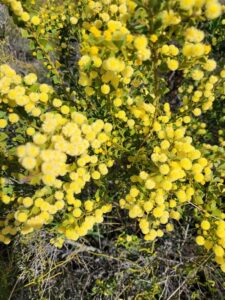How to Propagate Acacia acinacea

Propagating the Prickly Moses: A Guide to Cultivating Acacia acinacea
Introduction:
Acacia acinacea, commonly known as Prickly Moses, is a striking Australian native shrub renowned for its silvery-grey foliage, dense habit, and vibrant yellow flower spikes. Its drought tolerance and adaptability to poor soils make it a popular choice amongst gardeners seeking low-maintenance, aesthetically pleasing plants for landscaping. However, its propagation presents unique challenges, making successful cultivation a rewarding experience for the dedicated plant enthusiast. The unique aspects related to its propagation stem largely from its robust nature and potential for variations in seed viability.
Seed Germination:
Seed germination is a viable method for propagating Acacia acinacea, though it’s not always straightforward. Challenges include dormancy, which often requires stratification to break.
Challenges: Many seeds exhibit hard seed coats inhibiting water uptake. Germination rates can be inconsistent, even with pre-treatment.
Practical Tips: Scarification (nicking the seed coat with sandpaper or a file) is often necessary. Stratification, involving periods of cold and moist conditions (e.g., 3-4 weeks in moist vermiculite in the refrigerator), significantly improves germination rates. Sow seeds in a well-draining seed-starting mix, keeping the soil consistently moist but not waterlogged. Maintain warm temperatures (20-25°C) for optimal germination.
Rewards: Seed propagation offers the advantage of maintaining genetic diversity within a population of plants, and it allows for large-scale propagation. It is the most cost-effective method, particularly when many plants are needed.
Cuttings:
Cuttings are another viable, albeit more challenging, propagation method for Acacia acinacea.
Challenges: Hardwood cuttings are generally more successful than softwood cuttings, but rooting can still be slow and inconsistent. The success rate can be influenced by factors as diverse as the time of year, the precise cutting technique, and the growing conditions. Fungal diseases can attack cuttings.
Practical Tips: Take semi-hardwood cuttings in late spring or early summer from healthy, actively growing stems. Use a rooting hormone to increase the chances of success. Plant cuttings in a well-draining, sterile growing medium and provide a humid environment (e.g., using a propagator or covering with a plastic bag). Consistent, moderate humidity and warmth are crucial.
Rewards: Cuttings allow for the rapid multiplication of superior plants (with desirable characteristics) from existing stock plants. This allows better control over uniformity and specific traits.
Division:
Division is generally not a practical method for propagating Acacia acinacea. This species typically doesn’t readily form clumps or suckers suitable for division.
Tissue Culture:
Tissue culture propagation of Acacia acinacea is possible but generally requires specialized laboratory equipment and expertise. It’s not a method readily accessible to home gardeners.
Challenges: Establishing sterile cultures and maintaining aseptic conditions are critical to avoid contamination. Optimizing culture media to achieve rapid shoot multiplication and successful rooting requires significant trial and error and specialized knowledge.
Practical Tips: This method is best left to nurseries or research institutions with the facilities and trained personnel.
Rewards: Tissue culture offers the potential for large-scale propagation of disease-free, genetically uniform plants. It allows for propagation of particularly desirable, genetically rare cultivars.
Conclusion:
Propagating Acacia acinacea, while challenging, offers significant rewards. Seed germination, while presenting hurdles of dormancy, provides the most readily accessible method for generating genetic diversity. Cuttings, while requiring more care and potentially lower success rates, allow for the propagation of specific traits. Tissue culture offers high-throughput propagation but demands specialized resources. The unique satisfaction of successfully cultivating Prickly Moses lies not only in the beauty of the resulting plant but also in overcoming the propagation hurdles involved. Persistence, attention to detail, and a willingness to experiment are crucial for the aspiring propagator. Don’t be discouraged by initial setbacks – enjoy the journey of bringing these fascinating plants to life.